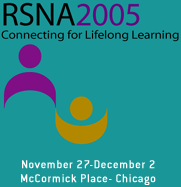
Abstract Archives of the RSNA, 2005
Anthony Thomas Stavros MD, Presenter: Nothing to Disclose
1) To present realistic versus unrealistic goals for sonographic detection of malignant breast nodules. 2) To show how the heterogeneity of breast cancer requires multiple findings. 3) To show how the sonographic algorithm is similar to the mammographic algorithm with extra steps of conservatism. 4) To discuss the rationale for classification of suspicious sonographic findings into "hard" and "soft" categories. 5) To demonstrate histopathologic and morphologic bases for suspicious sonographic findings. 6) To show techniques that maximize chances of detecting suspicious sonographic findings. 7) To present sensitivities of individual findings versus a panel of findings.
It is unrealistic to expect ultrasound to be able to distinguish all benign from all malignant breast nodules. We cannot, and likely never will be able to do so. However, it is realistic to try to correctly characterize 98% or more of malignant breast nodules into BIRADS 4 or 5 categories. It is also realistic to try to identify a subpopulation of benign solid breast nodules that can be characterized as benign with 98% or greater certainty (simply, to identify a BIRADS 3 subgroup of benign nodules).
Breast cancer is too heterogeneous to be detected with 98% or greater certainty using single findings. Breast cancers span a spectrum from circumscribed lesions on one end of the spectrum and spiculated lesions on the other end. There are also mixed circumscribed-spiculated lesions in the middle of the spectrum. Single findings tend to be effective only on one end of the spectrum and some of the mixed cases on the other end of the spectrum and some of the mixed cases in the middle. Only by using multiple findings can we expect to be able to detect 98% or more of cancers. This is a lesson learned previously from mammography. We would never use only a single finding in mammography. Thus, we use a panel of 9 sonographic findings, 6 of which are simply mammographic findings applied to ultrasound. We also use the same algorithm as we use in mammography with more conservative step and one extra step in the sonographic algorithm. The sonographic algorithm errs to the side of caution because a solid nodule can never be considered a negative finding and because sonographic characterization was considered risky when we began.
The nine sonographic findings can be classified as shapes, surface characteristics, and internal characteristics, but can also be characterized in a way that is unique to breast ultrasound. Findings can be classified into “hard” findings (spiculation, thick echogenic halo, angular margins, acoustic shadowing) that suggest the presence of invasive elements, “soft” findings (duct extension, branch pattern, calcifications) that suggest the presence of DCIS components of tumor, and mixed findings (microlobulation, hypoechoic echotexture, and axis that is not parallel to the skin or taller than wide) that can be seen with either invasion or DCIS. Including soft findings is important because most invasive lesions contain intraductal components. In many cases DCIS components lie on the surface of the lesion or extend for variable distances into surrounding tissues, affecting the shape and/or surface characteristics of the lesion enough to potentially change its imaging characteristics. The inclusion of soft findings should: 1) improve sensitivity for pure DCIS, for invasive tumors with extensive intraductal components, and for circumscribed invasive malignancies; and 2) allow more accurate assessment of the extent of disease in patients with malignant lesions.
The presence of even single suspicious sonographic finding, even if only a soft finding, increases the risk of malignancy to more than 2%, and therefore, must prevent a lesion from being characterized as BIRADS 3.
None of the individual findings are able to achieve a sensitivity for malignancy of 98% or greater because each finding tends to identify one end of the malignant spectrum more effectively than it detects the other end of the spectrum. However, by using this panel of multiple findings within the more conservative algorithm adapted from mammography, one can achieve sensitivity in excess of 98%. The average malignant breast nodule demonstrates 5 or 6 suspicious findings if scanned in its entirety in two orthogonal planes. Even if some of these 5 or 6 suspicious findings are not detected, other suspicious findings will be detected, and the lesion will not be mischaracterized as probably benign.
Only if there are no suspicious features should benign findings be sought. If there is a mixture of suspicious and benign findings, the benign findings must be ignored. Discussion of the search for benign findings, the completing step in the sonographic characterization algorithm, is a topic for another day.
Stavros, A,
Soft and Hard Sonographic Findings of Malignancy. Radiological Society of North America 2005 Scientific Assembly and Annual Meeting, November 27 - December 2, 2005 ,Chicago IL.
http://archive.rsna.org/2005/4404701.html

